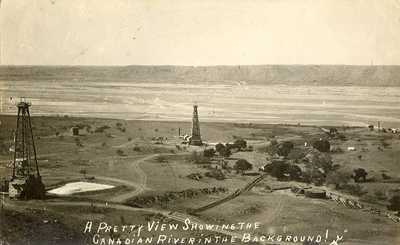|
Almost
every early day description, narrative and historical note written
about the Canadian
River uses the words "dangerous," "treacherous," "quicksand" and
"death." Whether man, beast or wagon was involved, the river often
took its toll.
Old
Tascosa was established because of the easy river crossing marked
by centuries-old buffalo trails. Another well-known crossing was at
Indian Creek, where gravel washed down from the creek during floods
provided a firm bottom across the river. At various times and at certain
locations along the river, men made a living guiding both wagons and
early automobiles across the channel. In some areas, lead steers and
river horses could be rented to help guide trail herds across the
flooded waterway. |
 |
Noted Panhandle
historian Cleo Tom Terry wrote of Canadian
River casualties. Iva Stovall, the Matador Ranch wagon boss, rode
off into the river at flood stage and neither he nor his horse were
ever seen again. Jay Taylor, a well-known Panhandle cattleman, once
had an employee ride into the river and dropped from sight instantly.
Mr. Taylor flew his airplane up and down the river for days afterward
but never found any sign of the cowboy and mount.
A pet phrase used by cowboys in describing the river was, "That old
river will bog a saddle blanket at times." All riverside ranches kept
a few river horses experienced in crossing quicksand. |
During
the early 1940s, we leased the old Parsell Ranch west of Canadian,
Texas. This was before cattle trucks and good roads, so almost
all cattle movement to and from market was made on the hoof. The easiest
way to the Canadian railroad stock facilities was to use the bottom
of the Canadian
River.
At that time, when the river was not flooding, the channel was a mile-wide
band of reddish colored sand often the site of dust storms if the
wind was from the west. The river bottom contained thousands of small
brush-covered islands of all sizes. You learned quickly the islands
were anchored by tangles of barbed wire washed down from upstream
during prior floods. At that time, my father believed the actual quicksand
spots were caused by live springs coming to the surface, keeping the
sand loose and disturbed.
We learned to watch the surface closely while riding. The experienced
river horses took quick, short steps, almost dancing to the side to
prevent the quicksand from sucking their feet downward.
Cattle not used to quicksand walked out to water to drink and instantly
sunk to their bellies, unable to free their legs. Most had to be rolled
over on their sides, freeing their legs before they could be pulled
or could scramble to safety.
Dad always made sure I was mounted on a bay horse named Two-Step.
When a "quickie place" appeared, Two-Step immediately shifted gears
over into "The Canadian River Two-Step" and sidled out to firmer ground.
At ten years old, I thought this was the most exciting thing that
had happened in my life.
© Delbert Trew
"It's All Trew" September
30, 2008 Column
See
Canadian River
Texas Rivers |
|
|
